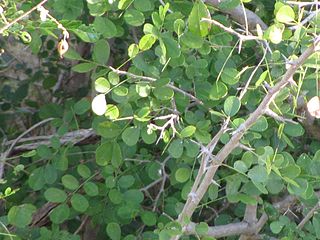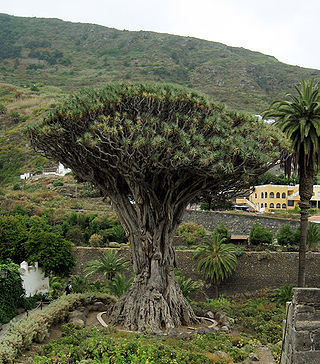
The International Union for Conservation of Nature (IUCN) Red List of Threatened Species, also known as the IUCN Red List or Red Data Book, founded in 1964, is an inventory of the global conservation status and extinction risk of biological species. A series of Regional Red Lists are produced by countries and organizations, which assess the risk of extinction to species within a political management unit.
Cypress is a common name for various coniferous trees or shrubs of northern temperate regions that belong to the family Cupressaceae. The word cypress is derived from Old French cipres, which was imported from Latin cypressus, the latinisation of the Greek κυπάρισσος (kyparissos). Cypress trees are a large classification of conifers, encompassing the trees and shrubs from the cypress family (Cupressaceae) and many others with the word “cypress” in their common name. Many cypress trees have needle-like, evergreen foliage and acorn-like seed cones.

Dalbergia melanoxylon in french Granadille d'Afrique is a flowering plant in the family Fabaceae, native to seasonally dry regions of Africa from Senegal east to Eritrea and south to the north-eastern parts of South Africa. The tree is an important timber species in its native areas; it is used in the manufacture of musical instruments and fine furniture. Populations and genomic resources for genetic biodiversity maintenance in parts of its native range are threatened by overharvesting due to poor or absent conservation planning and by the species' low germination rates.

Paulownia tomentosa, common names princess tree, empress tree, or foxglove-tree, is a deciduous hardwood tree in the family Paulowniaceae, native to central and western China. It is an extremely fast-growing tree with seeds that disperse readily, and is a persistent exotic invasive species in North America, where it has undergone naturalisation in large areas of the Eastern US. P. tomentosa has also been introduced to Western and Central Europe, and is establishing itself as a naturalised species there as well.

Dracaena draco, the Canary Islands dragon tree or drago, is a subtropical tree in the genus Dracaena, native to the Canary Islands, Cape Verde, Madeira, western Morocco, and is thought to be introduced in the Azores. Its closest living relative is the dragon blood tree of Socotra, Dracaena cinnabari.

Paulownia is a genus of seven to 17 species of hardwood tree in the family Paulowniaceae, the order Lamiales. The genus, originally Pavlovnia but now usually spelled Paulownia, was named in honour of Anna Pavlovna, queen consort of The Netherlands (1795–1865), daughter of Tsar Paul I of Russia. It is also called "princess tree" for the same reason.

Paulowniaceae are a family of flowering plants within the Lamiales. They are a monophyletic and monogeneric family of trees with currently 7 confirmed species. They were formerly placed within Scrophulariaceae sensu lato, or as a segregate of the Bignoniaceae.

The blue-chinned sapphire or blue-chinned emerald is a hummingbird that ranges from Colombia south and east to the Guianas, Trinidad and Tobago, Peru, and Brazil. There have been occasional records from Tobago. For Brazil, the species' range is along the main Amazon River Basin, as well as the Atlantic Forest, both in the northeast, as well as far south on the southeast coastal strip,. It is sometimes placed in the genus Chlorostilbon.

Gomortega keule is a tree native to Chile. It is the sole species of the genus Gomortega and, according to the APG IV system of 2016, of the monotypic family Gomortegaceae, assigned to the order Laurales in the clade magnoliids.
Wildcrafting is the practice of harvesting plants from their natural, or 'wild' habitat, primarily for food or medicinal purposes. It applies to uncultivated plants wherever they may be found, and is not necessarily limited to wilderness areas. Ethical considerations are often involved, such as protecting endangered species, potential for depletion of commonly held resources, and in the context of private property, preventing theft of valuable plants, for example, ginseng.

The Santa Cruz cypress is a species of North American tree within the Cypress family. The species is endemic to the Santa Cruz Mountains within the Santa Cruz and San Mateo counties of west-central California. The U.S. Fish and Wildlife Service listed the species on the Endangered Species Act in 1987 due to increasing threats from habitat loss and disruption of natural forest fire regimes. In 2016, the conservation status of the Santa Cruz cypress changed to Threatened. The cited reasoning was a decrease in threats against their habitat.

The Sir Harold Hillier Gardens is an arboretum comprising 72 hectares accommodating over 42,000 trees and shrubs in about 12,000 taxa, notably a collection of oaks, camellia, magnolia and rhododendron.

The gilded sapphire, also known as the gilded hummingbird, is a species of hummingbird in the "emeralds", tribe Trochilini of subfamily Trochilinae. It is found Argentina, Bolivia, Brazil, Paraguay, and Uruguay.

Abies kawakamii is a species of conifer in the family Pinaceae. It is found only in Taiwan. First described in 1908 by Bunzō Hayata as a variety of Abies mariesii, a high-mountain fir native to Japan; the next year it was elevated to species rank by Tokutarô Itô. Abies kawakamii is exclusively native to the island of Taiwan, and is one of the southernmost true firs. It is a high-mountain species occurring in northern and central Taiwan at elevations between 2400 and 3800 m in association with other temperate plants, dominantly conifers, including Juniperus formosana var. formosana, Tsuga formosana, and Juniperus morrisonicola.

Widdringtonia wallichii, Clanwilliam cedar or Clanwilliam cypress, previously Widdringtonia cedarbergensis is a species of Widdringtonia native to South Africa, where it is endemic to the Cederberg Mountains northeast of Cape Town in Western Cape Province. It is threatened by habitat loss and protected in South Africa under the National Forest Act of 1998.

Juania australis, the Chonta palm, is a species of flowering plant in the family Arecaceae, the only species in the genus Juania. It is a solitary trunked palm tree which is endemic to the Juan Fernández Islands archipelago in the southeast Pacific Ocean west of Chile.

Sabal pumos, known as the royal palmetto, is a species of flowering plant in the palm tree family, Arecaceae.
Castanopsis kawakamii is a species of plant in the family Fagaceae. It is found in China, Taiwan, and Vietnam. It is threatened by habitat loss.

Ocotea porosa, commonly called imbuia or Brazilian walnut, is a species of plant in the Lauraceae family. Its wood is very hard, and it is a major commercial timber species in Brazil.
Terminalia ivorensis is a species of tree in the family Combretaceae, and is known by the common names of Ivory Coast almond, idigbo, black afara, framire and emeri.


















